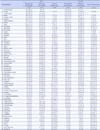Abstract
Purpose
This study is to measure oral health literacy levels and to identify oral health literacy related factors in elders.
Methods
The research design for this study was a descriptive survey design using convenience samples. Data collection was done by using a self-report questionnaire with 321 elders from three welfare centers for the aged and two senior centers located in three cities. Data were analyzed by using percentage, mean, standard deviation, t-test, ANOVA, Scheffé, Pearson's Correlation Analysis and hierarchical multiple regression with the SPSS Win 18.0 Program.
Results
The oral health literacy scores of male elders were higher than those of female elders (t=9.73, p=.002). In hierarchical multiple regression analysis, education levels, smoking and oral health statuses were significant predictors and accounted for 29.8% of the male elders' oral health literacy. For female elders, education levels, health statuses and oral health statuses were significant predictors and accounted for 47.7%.
Figures and Tables
References
1. Ministry of Health & Welfare. Korea health statistics 2010: Korea national health & nutrition examination survey (KNH ANES V-1) [Internet]. Seoul: Ministry of Health & Welfare;2009. cited 2013 September 3. Available from: http://knhanes.cdc.go.kr/knhanes/index.do.
2. Richmond S, Chestnutt I, Shennan J, Brown R. The relationship of medical and dental factors to perceived general and dental health. Community Dent Oral Epidemiol. 2007; 35(2):89–97.

3. Song KH. A study on the evaluation oh health-and oral health-related quality of life in Korean adults [dissertation]. Seoul: Hanyang University;2007. 125.
4. Gazmararian JA, Williams MV, Peel J, Baker DW. Health literacy and knowledge of chronic disease. Patient Educ Couns. 2003; 51(3):267–275.

5. Ickes MJ, Cottrell R. Healthy literacy in college students. J Am Coll Health. 2010; 58(5):491–498. http://dx.doi.org/10.1080/07448481003599104.
6. Ministry of Health & Welfare. National health information portal service [Internet]. Seoul: Ministry of Health & Welfare;2013. cited 2013 September 3. Available from: http://health.mw.go.kr/Main.do.
7. Lee YT, Yoon TY, Kim SH. Functional health literacy and understanding of explanation according to characteristics of patients. Health Soc Sci. 2012; 32(2):145–171.
8. Lee JY, Divaris K, Baker AD, Rozier RG, Vann WF Jr. The relationship of oral health literacy and self-efficacy with oral health status and dental neglect. Am J Public Health. 2012; 102(5):923–929. http://dx.doi.org/10.2105/AJPH.2011.300291.

9. Institute of Medicine. Health literacy: A prescription to end confusion. Washington. DC: National Academies Press;2004. p. 41.
10. Kim CS. Gender differentials of economic resources in old age. Korea J Popul Stud. 2003; 26(1):59–77.
11. Kim SH, Lee E. The influence of functional literacy on perceived health status in Korean older adults. J Korean Acad Nurs. 2008; 38(2):195–203.

12. Park JY, June KJ. Influencing factors on functional health literacy among the rural elderly. J Korean Acad Community Health Nurs. 2011; 22(1):75–85.

13. Ju HJ, Oh HW, Kim JY, Lee HS. A cross-sectional study on oral health literacy and its influencing factors among adults: I. verbal oral health literacy. J Korean Acad Oral Health. 2012; 36(2):97–105.
14. Lee GJ. Factors affecting activities for oral health promotion [dissertation]. Daegu: Hanny University;2010. 103.
15. Richman JA, Lee JY, Rozier RG, Gong DA, Pahel BT, Vann WF Jr. Evaluation of a word recognition instrument to test health literacy in dentistry: the REALD-99. J Public Health Dent. 2007; 67(2):99–104.

16. Naghibi Sistani MM, Yazdani R, Virtanen J, Pakdaman A, Murtomaa H. Determinants of oral health: does oral health literacy matter? ISRN Dentistry. 2013; 3(13):1–6. http://dx.doi.org/10.1155/2013/249591.

17. Hwang TY. Understanding health literacy: Implications for medicine and public health. Seoul: Academy Press;2010. p. 202.
18. Kim SS, Kim SH, Lee SY. Health literacy: Development of a Korean health literacy assessment tool. J Korean Soc Health Educ Promot. 2005; 22(4):215–227.
19. Jung JO, Oh GJ. A study of the relationship between socioeconomic status, oral health behaviors and periodontitis in the elderly Korean population. J Korean Acad Oral Health. 2011; 35(1):57–66.
20. Nam YS. Influence factors associated with oral health status and the of oral health on the quality of life in older Korean adults [dissertation]. Gyeonggi-do: Ajou University;2012. 97.
21. Kutner M, Greenberg E, Jin Y, Paulsen C. The health literacy of America's adults results from the 2003 national assessment of adult literacy. Washington DC: US Department of Education;2006. p. 76.
22. Schwartz L, Woloshin S, Black WC, Welch HG. The role of numeracy in understanding the benefit of screening mammography. Ann Intern Med. 1997; 127(11):966–972.

23. Kim JE. Measuring the level of health literacy and influence factors: trageting the visitors of a university hospital's outpatient clinic. J Korean Clin Nurs Res. 2011; 17(1):27–34.
24. Moon HJ. Factors related to antihypertensive medication adherence and blood pressure control among older adults [master's thesis]. Seoul: Yonsei University;2008. 75.
25. Gwak JH. Impacts of tobacco on oral health [master's thesis]. Seoul: Seoul National University;2012. 95.
26. Wolf MS, Gazmararian JA, Baker DW. Health literacy and health risk behaviors among old adults. Am J Prev Med. 2007; 32(1):19–24.
27. Davis TC, Crouch MA, Long SW, Jackson RH, Bates P, George RB, et al. Rapid assessment of literacy levels of adult primary care patients. Fam Med. 1991; 23(6):433–435.




 PDF
PDF ePub
ePub Citation
Citation Print
Print







 XML Download
XML Download